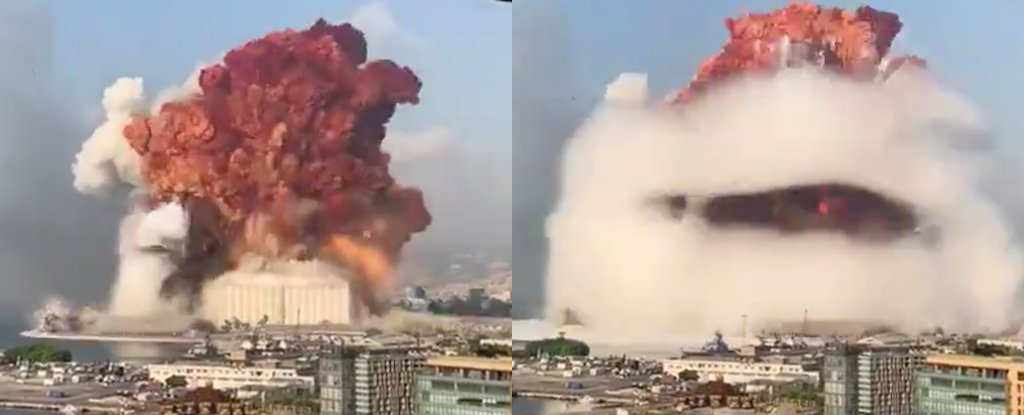Products You May Like
When an enormous explosion created a mushroom cloud over Beirut, killing dozens of people and injuring thousands more, online commentators and conspiracy theorists quickly jumped to a frightening claim: A nuclear bomb had gone off in Lebanon’s capital city.
But as state officials say, and contrary to those fast-spreading rumours, the explosion was almost certainly not caused by a nuclear weapon.
Even before Lebanese officials said the explosion was caused by a large stockpile of ammonium nitrate stored in a warehouse at the port, according to The Guardian, experts who study nuclear weapons quickly and unequivocally rejected the idea that Beirut had been hit with a nuclear bomb.
Key to those rejections are the videos that Beirut residents managed to record video of the huge detonation.
Footage of the massive explosion at #Beirut port a short while ago. It’s truly frightening. #Lebanon pic.twitter.com/OZ0hZ5SwlC
— Nader Itayim | نادر ایتیّم (@ncitayim) August 4, 2020
People trained cameras on the Beirut port at the time of the blast because a worrisome cloud of smoke rose beforehand. Some of those videos show small flashes of light and reports (or sounds) that are distinctive to fireworks.
Moments later, the huge explosion – which came with a visible blast wave and mushroom-like cloud of smoke – rocked the area, destroying nearby buildings and shattering distant windows.
In a tweet that accumulated thousands of likes and reshares before it was deleted, one user wrote: “Good Lord. Lebanese media says it was a fireworks factory. Nope. That’s a mushroom cloud. That’s atomic.”
Vipin Narang, who studies nuclear proliferation and strategy at the Massachusetts Institute of Technology, immediately spiked the claim. “I study nuclear weapons. It is not,” Narang tweeted on Tuesday.
Martin Pfeiffer, a PhD candidate at the University of New Mexico who researchers the human history of nuclear weapons, also rejected assertions on social media that a “nuke” caused the blast. “Obviously not a nuke,” Pfeiffer tweeted, saying later: “That’s a fire setting off explosives or chemicals.”
Seven different angles of the massive explosion in Beirut, Lebanon from this morning.
My goodness…pic.twitter.com/4no1brIYoD
— Rex Chapman🏇🏼 (@RexChapman) August 4, 2020
Pfeiffer indicated that the explosion lacked two hallmarks of a nuclear detonation: a “blinding white flash” and a thermal pulse, or surge of heat, which would otherwise start fires all over the area and severely burn people’s skin.
The explosion did trigger a powerful blast wave that apparently shattered windows across Beirut, and it was briefly visible as an expanding, shell-like cloud – something often seen in historic footage of nuclear detonations.
But Pfeiffer noted such blast-wave clouds, known to weapons researchers as a “Wilson Cloud,” are made when humid air gets compressed and causes the water in it to condense. In other words: They aren’t unique to nuclear bombs.
A back-of-the-envelope calculation reshared on Twitter by Narang suggests the blast was equivalent to around 240 tons of TNT, or about 10 times as large as the US military’s “mother of all bombs” or MOAB is capable of unleashing. By contrast, the “Little Boy” bomb that the US dropped on Hiroshima in 1945 was about 1,000 times as powerful.
As a counterpoint to suggestions the Beirut explosion was caused by a nuclear weapon, Pfeiffer offered a video showing the detonation of a rocket-propelled “Davy Crockett” nuclear weapon, which exploded with a force equivalent to about 20 tons of TNT.
The Davy Crockett was one-tenth as strong as the Beirut explosion, but had a distinctive flash that’s missing from Tuesday’s blast. No reports suggest there was any radioactive fallout after the Beirut blast, which would have been quickly detected.
It’s not crazy to wonder if a large blast in a populous city might be an act of nuclear terrorism, of course. In fact, it’s one of 15 disaster scenarios that the US government has simulated and planned for (to the point it created scripts for local authorities to use after such an attack).
But in this case, Beirut’s tragedy was not in any way nuclear.
This article was originally published by Business Insider.
More from Business Insider:
